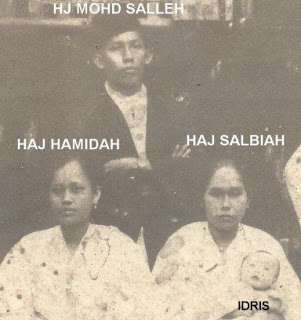 |
| Ketupat beras daun kelapa |
dan Selamat Hari Raya Aidil Adha.
Tidak lengkap rasanya ketika menyambut hari raya, baik Hari Raya Aidilfitri mahupun Hari Raya Aidil Adha jika tidak ada hidangan juadah tradisi yang diwarisi turun temurun.
Juadah yang paling istimewa itu adalah ketupat beras daun kelapa, ketupat pulut daun palas, lemang, rendang daging atau rendang ayam, urap kelapa dan sambal tumis udang.
 |
| Ketupat pulut daun palas |
sebenarnya memerlukan kemahiran yang harus dituntut turun temurun dari nenek moyang hinggalah kepada cucu cicit.
Inilah keunikan juadah tradisi Melayu yang dihidangkan pada hari-hari perayaan khasnya pada hari raya.
Ketupat Beras Daun Kelapa
Seseorang perlu terlebih dahulu tahu menganyam kelongsong daun ketupat yang diperbuat dari daun kelapa muda.
 |
| Lemang |
 |
| Rendang daging atau rendang ayam |
MokDah mengambil masa yang lama untuk belajar menganyam daun ketupat dari nenek hinggalah kepada ibu. Sayang betul anak-anak sekarang ramai yang tidak minat belajar, lebih mudah beli yang dah siap.
Proses merebusnya juga memakan masa antara 2 hingga 4 jam bergantung kepada ketupat sudah cukup kembang dan padat atau tidak.
 |
| Urap kelapa |
Seseorang juga perlu tahu untuk melipat kelongsung ketupat daun palas berbentuk tiga segi.Nampak mudah, tapi kalau tak tahu tekniknya tak menjadi.
Cara menyediakannya:
2 kg pulut (pulut susu)
2 1/2 kg santan pekat
sedikit garam
daun palas:
Basuh beras pulut dan tos.
Masak snatan dengan api perlahan, kacau sehinga mendidih.Masukan sedikit garam dan biarkan mendidih dan kecilkan api. Masuk pulut dan gaul sebati dengan santan. Bila sudah separuh masak dan snatan dah kering, turunkan.
Bila sudah sejak masukan pulut kedalam kelongsong.
Rebus semula ketupat palas tersebut dalam periuk bersama santan cair yang sama paras dengan ketupat, biar hingga kering.
Lemang
Untuk lemang pula prosesnya lebih rumit dimana buluh lemang harus disediakan terlebih dahulu dan dialas dengan daun pisang.
Cara menyediakannya:
 |
| Sambal tumis udang |
* 1 kg beras ketan
* 1 liter santan kelapa
* 1 sudu teh garam halus
* 1 pelepah daun pisang yang muda sikit
* 1 batang buluh lemang yang sudah siap dibersihkan dari buluh bambu
Rendam beras selama 4 jam dan kemudian toskan. Kemudian masukan santan dan garam, Masukan beras kedalam buluh lemang anggaran 3/4 (tidak terlalu penuh) dan panggang dengan menggunakan kayu bakar atau arang, lemang perlu di puisng-puisngkan.
Proses memasaknya juga memakan masa dan perlu banyak kesabaran kerana ia harus dipanggang di bawah bara api sehingga masak.
Rendang Daging atau Rendang Ayam
Terdapat berbagai jenis rendang yang boleh dimasak terpulang kepada selera masing-masing, diantara rendang tersebut adalah rendang pedas, rendang minang atau rendang negeri sembilan, rendang tok dan rendang padang.
Selain daripada rendang daing atau rendang ayam, ramai juga yang sudah mencampurkan rnedang daing dengan paru dan hati. Terpulang pada selera masing-masing.
Bahan asas kesemua rendang ini pada dasarnya tidak banyak beza, kecuali ada beberapa bahan tambahan serta cara menyediakannya.
Keluarga MokDah gemar kepada rendang minang.
Rendang Minang
Cara menyediakannya:
1 kilo daging atau seekor ayam
Santan pekat dari dua biji kelapa
3 sudu besar kerisik
1 keping asam keping
1 sudu besar jintan manis
1 sudu besar jintan putih
sedikit garam
Kisar bawang 1 labu bawang besar atau 3 ulas bawang merah, 3 ulas bawang putih, 1 inci kuyit hidup, 3 cm halia, 2 barang serai, 3 hiris lengkuas, 15 tangjau cili kering dan 5 biji cili merah dan sedikit cili padi. Tiga helai daun kunyit dan lima helai daun limau purut dihiris halus.
Panaskan minyak dan tumis bahan yang dikisar hingga keluar minyak, Masukan serbuk jintan manis dan jintan puith, kemudian masukan daging (sebaiknya direbus dulu) atau ayam. Bila ayam telah kecut atau daging hampur empuk masukkan santan pekat, kerisik, garam, asam keping dan bahan hirisan.Kacau hingga kering.
Bagi orang Melaka, tidak lengkap hidangan ketupat rendang jika tidak ada urap kelapa sebagai penambah selera.
Urap kelapa di perbuat daripada kelapa muda parut dan dicampur dengan hirisan bawang merah, daun kunyit, serai, daun limau purut dan udang kering tumbuk serta sedikit garam.
Kesemua bahan ini sangai atas kuali sehingga kering.
Sambal Tumis Udang
Bagi keluarga MokDah, sambal tumis udang adalah pelengkap juadah. Anak-anak MokDah suka makan ketupat nasi daun kelapa bersama sambal udang dan urap sahaja.
Selamat menjamu selera.
@11.09.2016




















